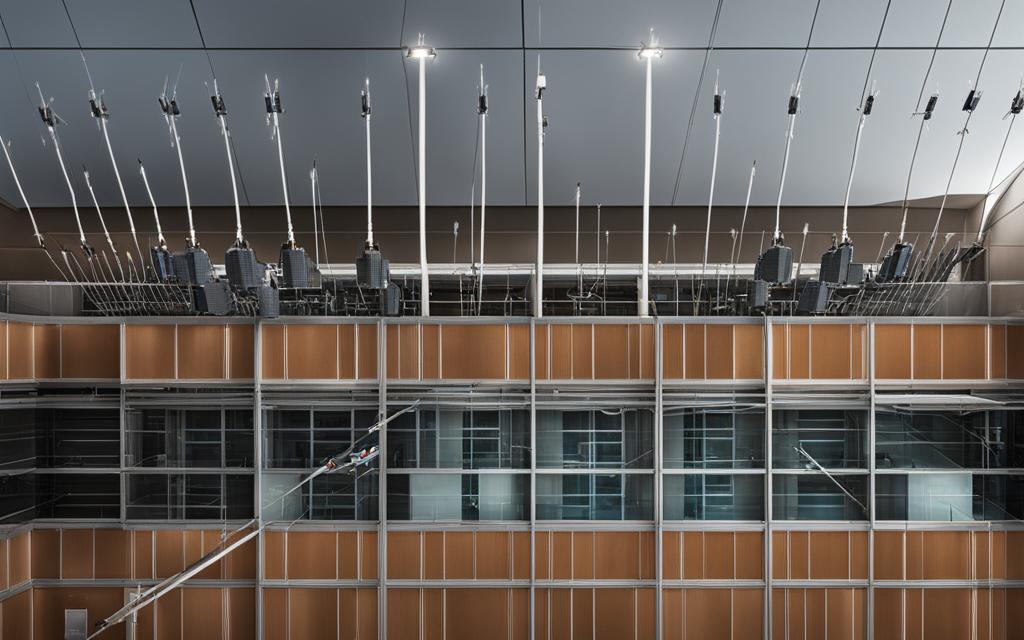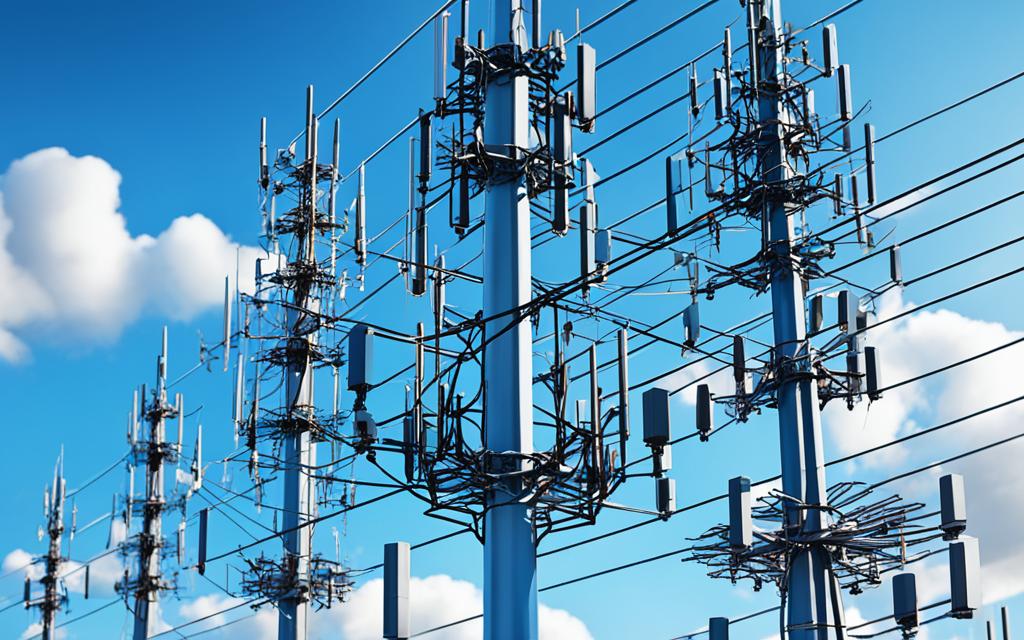In today’s connected world, reliable cellular connectivity is essential for staying connected with family, friends, and work. However, weak cell signals and dropped calls can be frustrating and disruptive. That’s where Distributed Antenna Systems (DAS) come in. DAS systems are innovative solutions designed to address cellular connectivity problems and enhance coverage in both large and small spaces.
Contrary to popular belief, DAS systems are not reserved only for massive venues like stadiums and airports. In fact, 90% of DAS deployments are in smaller spaces such as office buildings, hospitals, and shopping malls.
With DAS technology, weak cell signals can be amplified and distributed effectively, improving network performance and providing seamless cellular connectivity. Whether you’re in a bustling city or a remote area, DAS systems ensure that you can make calls, send messages, and access data without interruptions or frustrating dead zones.
Stay tuned to learn more about the components, benefits, and applications of DAS systems, as well as how they can revolutionize wireless connectivity in various industries and environments.
Understanding Distributed Antenna Systems (DAS)
A distributed antenna system (DAS) is a network of antennas designed to distribute and amplify wireless signals. It serves as a seamless solution to address the challenges of weak cell signals and ensure reliable wireless connectivity. DAS technology plays a crucial role in improving coverage and capacity in both indoor and outdoor environments.
DAS consists of several key components that work together to enhance wireless signals:
- DAS Headend: The headend serves as the central point of control for the DAS system. It processes and distributes wireless signals throughout the network.
- Fiber Optic Cables: Fiber optic cables are used to transmit data from the headend to the remote units and antennas. They provide fast and reliable transmission of signals over long distances.
- Remote Units: Remote units are responsible for receiving, processing, and amplifying wireless signals before distributing them through the antennas. They are strategically placed throughout the coverage area to ensure optimal signal distribution.
- Antennas: Antennas are the physical components that transmit and receive wireless signals. They are strategically placed to provide comprehensive coverage and eliminate dead zones.
Benefits of Distributed Antenna Systems
Distributed antenna systems offer numerous benefits that contribute to seamless connectivity:
- Improved Coverage: DAS technology enhances wireless coverage, ensuring that users have a strong and reliable signal in all areas of the coverage zone.
- Increased Capacity: By distributing and amplifying wireless signals, DAS systems can accommodate a larger number of simultaneous users without compromising performance.
- Enhanced Network Performance: DAS technology reduces signal congestion, leading to improved network performance, faster data speeds, and better call quality.
- Flexibility and Scalability: DAS systems are flexible and scalable, allowing for future upgrades and modifications to meet evolving connectivity needs.
Implementing a DAS system can result in seamless wireless connectivity, eliminating the frustration of dropped calls and weak signals. Whether it’s in a busy event venue, office building, or public space, DAS technology ensures that users can stay connected and enjoy uninterrupted communication.
https://www.youtube.com/watch?v=Q54GiouXFmE
Active vs. Passive DAS: Choosing the Right Solution
When it comes to enhancing cellular connectivity and signal distribution, it’s important to choose the right solution for your specific needs. Two popular options are active DAS and passive DAS. Let’s explore the differences between the two and determine which one is the best fit for your requirements.
Active DAS: Robust Connectivity for Large Areas
Active DAS is a powerful cellular connectivity solution designed for large areas such as airports and arenas. It creates cellular signals and distributes them between a centralized signal source and remote DAS nodes.
With active DAS, the focus is on generating and amplifying signals to provide seamless coverage in expansive spaces. However, this solution calls for a substantial investment of time, infrastructure, and capital, which may make it less suitable for smaller environments.
Passive DAS: Enhancing Existing Signals
Passive DAS, also known as a cell phone signal booster system, is an alternative option that enhances existing cell signals without creating new ones. It is designed to conform to FCC regulations and requires minimal infrastructure.
Passive DAS is a cost-effective solution that can be utilized in a wide range of settings. It works by leveraging existing signals and amplifying them to improve cellular connectivity. This makes it a practical choice for smaller spaces where active DAS might be excessive.
Here’s a visual representation comparing the features of active and passive DAS:
| Active DAS | Passive DAS | |
|---|---|---|
| Applicability | Suitable for large areas | Effective for smaller spaces |
| Infrastructure | Requires significant investment | Minimal infrastructure requirement |
| Signal Creation | Generates and distributes cellular signal | Enhances existing cell signal |
| Cost | Higher initial investment | More cost-effective option |
As the table demonstrates, active DAS is ideal for scenarios involving large areas and higher signal generation requirements. Passive DAS, on the other hand, is a more practical and cost-effective choice for smaller spaces.
Choose the right solution based on the size and specific needs of your location, whether it’s an expansive venue or a compact establishment. Both active and passive DAS solutions offer the potential to enhance cellular connectivity and improve signal distribution.

Optimizing cellular connectivity and signal distribution is crucial to ensure seamless communication in our modern world. By selecting the appropriate DAS solution, you can effectively address these needs and provide reliable wireless connectivity.
Components and Applications of DAS
A Distributed Antenna System (DAS) encompasses various components that work together to enhance cellular coverage and connectivity. From base stations to antennas, each element plays a vital role in ensuring seamless communication. Let’s explore the key components and applications of DAS.
DAS Components
1. Base Station: The base station acts as a central hub for a DAS deployment. It emits Radio Frequency (RF) signals that are distributed throughout the system.
2. Fiber Optics: Fiber optic cables are used to transmit data from the base station to the antennas. These cables provide reliable and high-speed connectivity, ensuring efficient signal transmission.
3. Radio Frequency Cables: Coaxial cables connect the antennas to the base station, enabling the transmission of RF signals. These cables are designed to minimize signal loss and maintain optimal performance.
4. Connectors and Splitters: Connectors play a crucial role in providing seamless connections between different components. Splitters are used to split the signal to multiple antennas, ensuring uniform coverage.
5. Antennas: Antennas are the key interface between the DAS and wireless devices. They broadcast and receive radio waves, facilitating the exchange of data between the devices and the network.
DAS Applications and Signal Sources
DAS finds wide applications in various industries and environments, improving wireless connectivity in:
- Public Venues: DAS is deployed in stadiums, convention centers, shopping malls, and other public spaces to ensure reliable coverage and capacity for large crowds.
- Healthcare Facilities: Hospitals, clinics, and healthcare centers rely on DAS to provide seamless connectivity for critical communication, medical devices, and patient care.
- Transportation Hubs: Airports, train stations, and bus terminals leverage DAS to enable uninterrupted communication and enhance passenger experience.
- Live Events: Music festivals, sports events, and conferences utilize DAS to support a high volume of simultaneous connections and enhance the overall attendee experience.
DAS can have various signal sources, including:
- Off-air Antennas: These antennas capture and amplify existing cellular signals, extending coverage and improving signal strength.
- Base Transceiver Stations (BTS): BTS act as signal sources for DAS, providing cellular coverage in areas where traditional macro cell towers may not be sufficient.
- Small Cells: Small cells are low-power cellular base stations that enhance coverage and capacity in specific areas with high user density.
DAS architecture, components, and signal sources work together to provide enhanced cellular coverage, improved network performance, and seamless connectivity in various settings and industries.
Benefits of DAS for Wireless Connectivity
Distributed Antenna Systems (DAS) offer a wide range of benefits for wireless connectivity. With its ability to enhance coverage, increase capacity, and improve network performance, DAS has become an essential solution for various industries and environments.
Enhanced Coverage and Elimination of Dead Zones
DAS significantly enhances coverage by extending the reach of wireless signals. By strategically placing antennas throughout an area, DAS eliminates dead zones, ensuring seamless connectivity in previously weak signal areas. This means that users can rely on consistent wireless coverage, without experiencing dropped calls or interruptions.
Increased Capacity for Concurrent Users
In today’s connected world, the demand for wireless connectivity continues to grow. DAS can support a large number of concurrent users, providing reliable connectivity even in high-density environments. With increased capacity, users can enjoy fast data speeds and seamless communication, regardless of the number of people connected to the network.
Improved Network Performance and Signal Quality
One of the key advantages of DAS is its ability to improve network performance, resulting in faster data speeds and better call quality. By reducing network congestion and optimizing signal distribution, DAS ensures that users have a smooth and uninterrupted wireless experience. Whether it’s downloading large files or making important calls, DAS enhances network performance to meet the demands of today’s digital world.
Flexibility and Scalability for Future Upgrades
DAS offers flexibility and scalability, making it a future-proof solution for wireless connectivity. As technology evolves and wireless standards change, DAS can easily adapt to meet new requirements. Whether it’s upgrading equipment or expanding coverage, DAS allows for seamless integration of new technologies without the need for significant infrastructure overhauls.
By leveraging the benefits of DAS, businesses and organizations can ensure reliable wireless connectivity, enhanced coverage, increased capacity, improved network performance, and the flexibility to adapt to future technological advancements.

| Benefits of DAS for Wireless Connectivity |
|---|
| Enhanced Coverage and Elimination of Dead Zones |
| Increased Capacity for Concurrent Users |
| Improved Network Performance and Signal Quality |
| Flexibility and Scalability for Future Upgrades |
Conclusion
Distributed antenna systems (DAS) have revolutionized wireless connectivity by providing seamless communication and enhanced coverage. Whether implemented in indoor or outdoor environments, DAS technology significantly improves network performance, increases capacity, and ensures reliable wireless connectivity.
The deployment of DAS is not limited to large venues like airports and stadiums. With 90% of DAS solutions catering to smaller spaces, such as offices, hospitals, and shopping malls, it has become an essential tool for overcoming weak cell signals and dropped calls.
By leveraging components such as antennas, fiber optic cables, and signal sources, DAS enhances the wireless signal distribution, eliminating dead zones and improving signal quality. This results in improved data speeds, better call quality, and an overall seamless communication experience.
As the demand for wireless connectivity continues to soar, DAS technology will undoubtedly play a pivotal role in shaping the future of wireless networks. With its ability to provide enhanced coverage, increased capacity, and improved network performance, DAS ensures that individuals and businesses can stay connected, informed, and productive in our increasingly digital world.
FAQ
What is a distributed antenna system (DAS)?
A distributed antenna system (DAS) is a network of antennas designed to distribute and amplify wireless signals. It consists of components such as the headend, fiber optic cables, remote units, and antennas. DAS can be deployed in both indoor and outdoor environments to improve wireless coverage and capacity.
How does DAS work to enhance cellular connectivity?
DAS works by enhancing cellular wireless signal through the installation of antennas and other components. It eliminates dead zones, improves network performance, and offers flexibility and scalability for future upgrades.
What are the differences between active DAS and passive DAS?
Active DAS is a robust, infrastructure-intensive cellular connectivity solution for large areas like airports and arenas. It creates cellular signal and distributes it between a centralized signal source and remote DAS nodes. On the other hand, passive DAS, also known as a cell phone signal booster system, enhances existing cell signal without creating new signal. It conforms to FCC regulations, requires less infrastructure, and is more cost-effective for a wide range of users.
What are the components of a DAS system?
DAS consists of various components, including a base station, fiber optics, radio frequency cables, connectors, splitters, and antennas. The base station acts as a central hub and emits RF signals that are distributed through coaxial cables. Fiber optics transmit data from the base station to the antenna. Coaxial cables connect the antennas to the base station. Antennas broadcast and receive radio waves. DAS can have different signal sources, including off-air antennas, base transceiver stations (BTS), and small cells.
Where can DAS be used?
DAS can be used in various industries and environments, such as public venues, healthcare facilities, transportation hubs, and live events.
What are the benefits of using DAS for wireless connectivity?
DAS brings numerous benefits to wireless connectivity. It enhances coverage, eliminates dead zones, and increases capacity to support a large number of concurrent users. DAS improves network performance by reducing congestion and improving signal quality, resulting in faster data speeds and better call quality. It also offers flexibility and scalability for future upgrades, adapting to changing wireless technology standards.



















